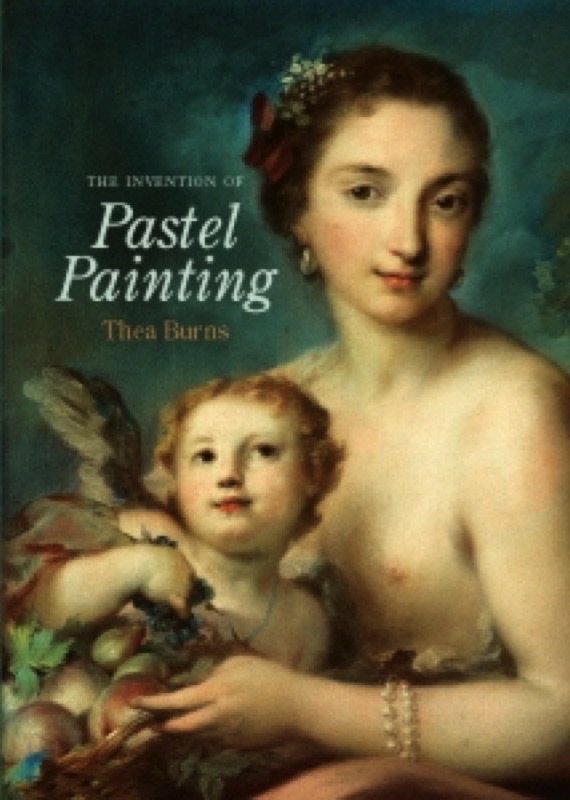Chalks and pastels are particularly appropriate materials for portraits because they appear effortlessly to convey the warm tones and soft, matte velvety surface of skin. Portraits and head studies therefore figure prominently in histories of pastel.
The Invention of Pastel Painting describes the relatively sudden emergence in the later seventeenth century of sets of friable pastel sticks and a new artistic practice of painting in pastel. The author reconsiders the use of natural and fabricated drawing sticks as tools, firmly locating their use in the context of historical function. 'Artistic techniques have a social history; they are signs endowed with cultural meaning by society.'
The visual, documentary and etymological evidence does not support the concept of a narrative history of pastel gradually progressing from a 'simple' original state in the drawings of Leonardo da Vinci, Jean and Francois Clouet and the Dumonstiers to an increasingly richly coloured and technically complex visual record in the paintings of Robert Nanteuil, Joseph Vivien and Rosalba Carriera, and then continuing to evolve through the nineteenth century.
In considering the history of chalk and pastel, the author argues that the change is aesthetic, not formal, and is grounded in social function and technical response. She has drawn not only on artists' letters and accounts, documents, critical and theoretical writings, and, broadly, the secondary literature, but also on close visual examination and scientific analysis of selected chalk drawings and paintings in pastel, particularly those created between 1500 and 1750.
Acknowledgements
Introduction
Chalk and pastel
Distinguishing between chalk and pastel in drawings, words and texts
Historical meanings of 'pastel'
Evidence for naturally occuring coloured chalk drawing sticks
Painting with pastel
Painting in pastel: a new artistic practice
Evidence from contemporary texts
Sets of pastels
The pastellist's tools
The paper support
Pastel: a socially appropriate substitute for oil painting
Robert Nanteuil and the prestige of painting in pastel
Evidence for materials and techniques
Paper supports
Painting pastel portraits
Relationship of function to material
A small portrait in graphite on parchment
Thesis portraits
'New heights': Joseph Vivien's large-scale pastel portrait paintings
The reception of Vivien's pastel paintings
Vivien's activity as a pastel painter
Material and technical evidence
Vivien's choice of pastel
Summary
Making up the face: technique and meaning in Carriera's pastel portraits
Carriera's pastel portraits
Carriera's achievement in pastel: pleasurable deception, fragile illusion
Fashion, appearance and class
Ideals of beauty
Painting the face: pastel and make-up
Venetian prototypes
Carriera's materials and working practice
Carriera's papers
Paper colour
Carriera's sources of blue paper
Additonal characteristics of Carriera's papers
Carriera's working procedures
Secondary support
Primary support preparation
Preparatory drawings, underdrawings and underpainting
The pastel painting
Brushwork
Sources of Carriera's pastel sticks
Summary
Presenting pastel portraits
Introduction
Material issues affecting presentation
Glazing
Frames
Evidence for reconstructing the presentation of pastels
Abundance or restraint: public versus private display
Framing in themed groups
Fixatives and 'the precious powder ... which falls off as easily as scales from a butterfly's wings'
Pastel in the nineteenth century
Appendix 1 Index to art-making and related topics in Carriera's correspondence
Appendix 2 Currency, wages and measurement
Appendix 3 Conditions of examination
Appendix 4 The conservation of pastels
Appendix 5 Earlier related publications by the author
Notes
References
Index
Reviews
...a handsome and welcome addition to the excellent library of conservation and art historical literature available from Archetype Publications...The Invention of Pastel Painting is an invaluable reference book for conservators, art historians, connoisseurs, educators, custodians and collectors on all aspects of the medium.
Journal of the Canadian Association for Conservation 33 (2008) 49-50
Thea Burns has produced an exceptional book on an esoteric and seductive subject - the invention and early history of the art of pastel painting. For conservators working on pastels from any period, this volume is an excellent one to read and keep as reference, as it covers the topic with an amount of detail unseen in previous works on the subject...For all interested readers, it is an engaging and informative book which should form part of any serious collection of books on artists' materials and techniques.
Journal of the Institute of Conservation 32(1) (March 2009) 129-131
The Invention of Pastel Painting is the first publication to fully distinguish, characterize, and establish a historical usage of pastels through the study of primary source material and technical examination of selected works from 1500 to 1750 executed in dry friable color...[It] provides a unique contribution to the subject of pastel, one that clearly defines the historic medium and provides a foundation upon which future historical and conservation-related research could be built.
Journal of the American Institute for Conservation 49 (2010) 115-117
You can find another review here from the Journal für Kunstgeschichte 15, 2011, Heft 4 (in German)
